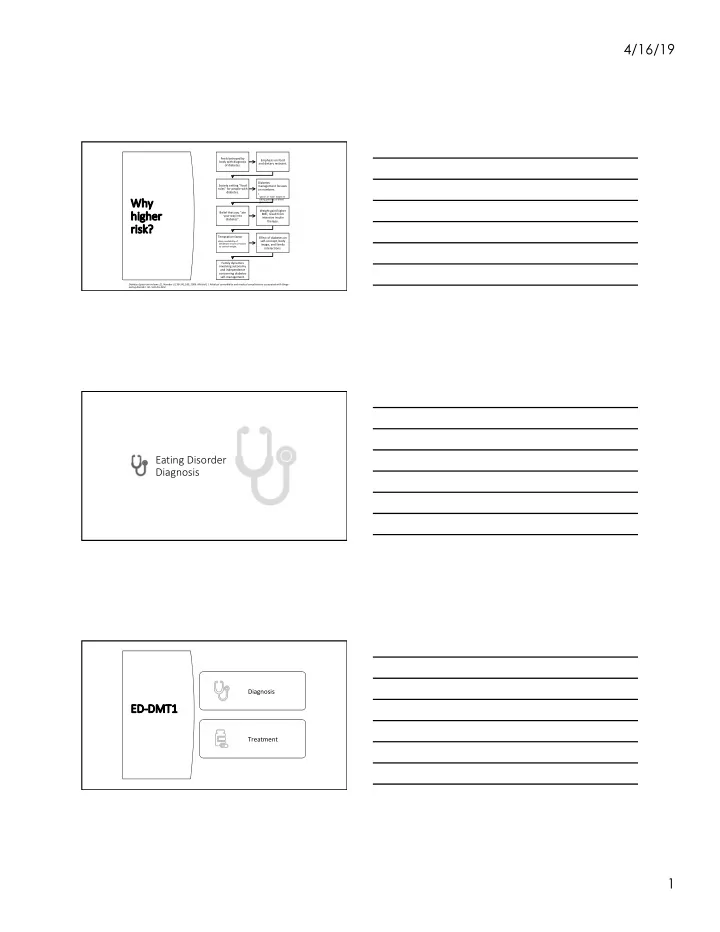

4/16/19 Feels betrayed by Emphasis on food body with diagnosis and dietary restraint. of diabetes. Diabetes Society setting “food management focuses rules” for people with on numbers. diabetes. • Patient judges self being "good" or "bad" based on Why Wh y eating patterns or blood glucose level. Weight gain/higher Belief that you “ate higher highe r BMI, result from your way into intensive insulin diabetes”. therapy. risk? risk? Temptation factor Effect of diabetes on • Easy availability of self-concept, body deliberate insulin omission image, and family to control weight. interactions. Family dynamics involving autonomy and independence concerning diabetes self-management. Diabetes Spectrum volume 22, Number 3,138-141,160, 2009. Mitchell, J. Medical comorbidity and medical complications associated with Binge- eating disorder. Int J Eat Dis 49:3. Eating Disorder Diagnosis Diagnosis ED-DMT ED-DMT1 Treatment 1
4/16/19 Treatme ment and Recovery: it it’s a pr s a process ess MULTIDISCIPLINARY DIABETES INFORMED STANDARD ED PERFECTIONISM – TEAM TREATMENT COMBINED TREATMENT ATTAINABLE GLUCOSE WITH TECHNIQUES/THERAPIES TARGET GOALS Ann Goebel-Fabbri (2017) Injecting Hope: Prevention and recovery from eating disorders in diabetes. Social Media Resource 2
4/16/19 Gr Graduate S e Sch chool ool R Res esea earch ch Diabetes Daze: How Adolescent Patients are Affected by Messaging • Illness Perception • Social Learning Theory • Peer, Media, Medical Professional & Parental Messages 18 - regarded negative lifestyle choice. Q: Q:11 2 - included a meme. ne negativ tive ex experience 6 - being perceived as different than a typical healthy adolescent, or a misunderstanding of the illness. 32 3
4/16/19 75% told of a person having misinformation. 40.6 % reported that they had a Results Re negative experience where they were called overweight. 71% say a motivating factor in improving self-management is curability/controllability. 5 best communication tips when talking to patients Feeling isolated. Misunderstood. #1Listen Need a safe outlet to talk things out. Be a great listener & you will gain trust. Give your patient a choice in their care. 4
4/16/19 NEVER scold – we live with this disease 24/7 and there’s a high rate of burnout. #2 no judgement Patients have been told since their diagnosis terms such as… Good Good Good food Good A1c & number & weight & & bad food. bad A1c. bad number. bad weight. What’s important to your patient (not diabetes or ED related)? Hobbies #3 motivate Interests Passions Future aspirations First diagnosed, I was Tried to hide having so sad about the diabetes. diagnosis. #4 use humor With diabetes, just like Marcia taught me that I with most things in life, couldn’t internalize I needed to find the humor in the disease everything when I could. 5
4/16/19 Patients with type 1 diabetes self-manage 90-95% of the time. #5 coach Preaching, rather than suggesting. Power of perspective. Six Themes Judgment (non-compliant, uncontrolled, don’t care, should, failure) Fear/Anxiety (complications, blindness, death, DKA) What words Labels/Assumptions (diabetic, all people with diabetes are fat, suffer) negatively Oversimplifications/Directives (lose weight, you should, you’ll get used to it, at affect you? least it’s not…) Misunderstanding/Misinformation/Disconnected (cure, reverse, bad kind, you’re fine) Body Language and Tone (no eye contact, accusatory tone) (Dickinson, 2018) Diabetes is a complex and challenging disease involving many factors and variables Stigma that has historically been attached to a diagnosis of diabetes can contribute to stress and feelings of shame and Guiding judgment principles Every member of the healthcare team can serve people with diabetes more effectively through a respectful, inclusive, and person-centered approach Person-first, strengths-based, empowering language can improve communication and enhance motivation, health and well-being of people with diabetes. Dickinson, J.K. (2018). The experience of diabetes-related language in diabetes care. Diabetes Spectrum, 31 (1), 58-64. 6
4/16/19 Use language that Is neutral, nonjudgmental, and based on facts, actions, or physiology/biology Is free from stigma Recommendations Is strengths-based, respectful, inclusive, and imparts hope Fosters collaboration between patients and providers Is person centered Dickinson, J.K. (2018). The experience of diabetes-related language in diabetes care. Diabetes Spectrum, 31 (1), 58-64. Words are powerful Words create meaning The message about Meaning can be positive or negative messages We can choose positive, strengths-based language to send messages that empower When our mindset changes to putting the person first, the language will Remove labels, remove blame/shame/guilt follow Dickinson, J.K. (2018). The experience of diabetes-related language in diabetes care. Diabetes Spectrum, 31 (1), 58-64. Problematic Preferred Diabetic Person living with diabetes Test (blood glucose) Check / monitor Control (verb) Manage; describe what the Becoming person is doing aware of and Control (noun) Define what you mean by control and use that instead (blood changing glucose level, A1C) our words Good/Bad/Poor Safe/unsafe levels; target levels; use numbers and focus on facts instead of judgmental terms Compliant / Adherent Takes medicine about half the time; Eats vegetables a few times a week; engagement; participation Dickinson, 2018. 7
4/16/19 46 47 8
4/16/19 48 Contact me: www.QuinnNystrom.com quinn@datelinediabetes.org Follow me @QuinnNystrom: 9
Recommend
More recommend